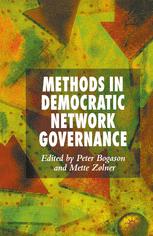

Most ebook files are in PDF format, so you can easily read them using various software such as Foxit Reader or directly on the Google Chrome browser.
Some ebook files are released by publishers in other formats such as .awz, .mobi, .epub, .fb2, etc. You may need to install specific software to read these formats on mobile/PC, such as Calibre.
Please read the tutorial at this link. https://ebooknice.com/page/post?id=faq
We offer FREE conversion to the popular formats you request; however, this may take some time. Therefore, right after payment, please email us, and we will try to provide the service as quickly as possible.
For some exceptional file formats or broken links (if any), please refrain from opening any disputes. Instead, email us first, and we will try to assist within a maximum of 6 hours.
EbookNice Team

Status:
Available4.5
35 reviews
ISBN 10: 140399529X
ISBN 13: 978-1403995292
Author: Peter Bogason, Mette Zølner
Methodological questions about how to study democratic network governance have so far received little research attention. This book aims to remedy this by addressing some important methodological questions in relation to case studies of the multilevel network governance of employment policy in Britain, France and Denmark.
1 Methods for Network Governance Research:an Introduction Peter Bogason and Mette Zølner
1.1 Why a book on methodology?
1.2 What is network governance?
1.3 Empirical research on network governance
1.4 Methodology
1.5 Structure of the book
Notes
2 A Comparative and Multi-level Analysis of GovernanceNetworks: a Pilot Study of Employment Policy J
2.1 Selection of scope, policy area, countries and sites
2.2 Research strategy: output-based backward mapping
2.3 Multiple methods
2.4 Managing collective research processes anddata collection
2.5 Lessons learned from the pilot study
3 Empirical Findings: Seven Network Stories Jacob Torfing
3.1 The transnational governance network
3.2 The Danish national governance network
3.3 The English national governance network
3.4 The French national governance network
3.5 The local governance network in Køge
3.6 The local governance network in Birmingham
3.7 The local governance network in Grenoble
3.8 Summing up
4 Comparative Analysis Based on Expert Reports Jacob Torfing
4.1 Introduction
4.2 Comparative studies based on expert reports
4.3 A critical assessment of the use of expert reports
4.4 How should expert reports be analysed?
4.5 Assessing and analysing expert reports
4.6 Lessons learned
5 Document Analysis of Network Topography and Network Programmes Anders Esmark and Peter Triantafill
5.1 Introduction
5.2 Different ways of reading documents
5.3 Documents lost and found
5.4 Analysing network topography
5.5 Analysing network programmes
5.6 Conclusions
6 Qualitative Interviews: Studying Network Narratives Mette Zølner, Iben Ørum Rasmussen and Allan
6.1 Introduction
6.2 Qualitative interviews in relation to the studyof network governance
6.3 Selecting respondents
6.4 Conducting interviews
6.5 Analysing policy actors’ narratives on labourmarket governance
6.6 Conclusion
Notes
7 Studying Local Network Exclusion through Observation and Diaries Eva Sørensen and Jacob Torfing
7.1 Introduction
7.2 Observation studies and diary writing
7.3 Undertaking observation and diary studies in Køge,Birmingham and Grenoble
7.4 The data material and how it was analysed
7.5 Analysing observations and diaries: sometentative research results
7.6 Concluding remarks on the use of observationand diaries in network studies
8 Interactive Focus Group Interviewing in Studies of Network Governance Bodil Damgaard and Eva Søre
8.1 Introduction
8.2 Interactive focus group interviewing andnetwork governance
8.3 Practical application
8.4 Analysing network governance through focusgroup interviews
8.5 Lessons from interactive focus group interviewingin studies of governance networks
9 Combining Qualitative and Quantitative Methods for the Analysis of Network Governance: Promises,Pr
9.1 The promises of method-mixing for the analysisof network governance
9.2 Experiences from the pilot study: the problems
9.3 Experiences from the pilot study: the pay-offs
9.4 Potentials: lessons learned and future directions
Notes
10 Conclusion Peter Bogason and Mette Zølner
10.1 Questions and answers
10.2 Challenges in the research process
10.3 Final points
methods for delivering governance
democratic methods
democratic network governance
networked democracy
modes of network governance structure management and effectiveness
Tags: Peter Bogason, Mette Zølner, Democratic Network